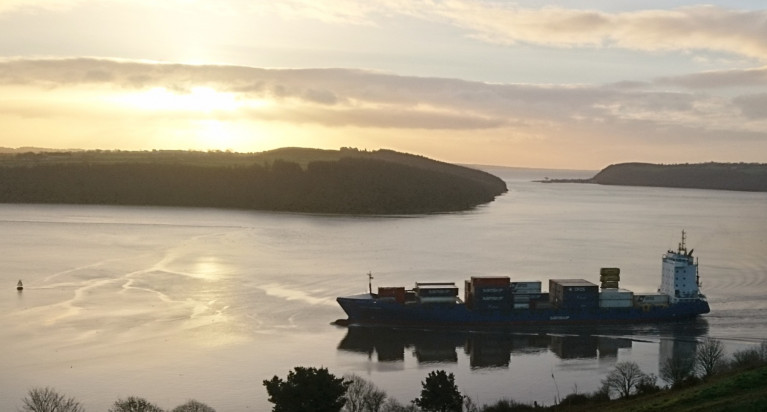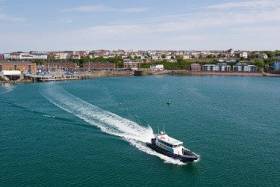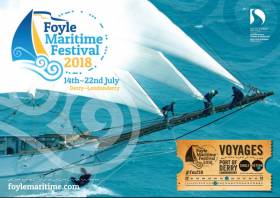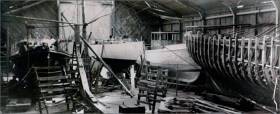Displaying items by tag: Maritime Heritage
1000 Years of the Strangford Ferry, Just One of Eleven Lectures at Bangor Maritime Heritage Conference
A full turnout of Maritime Heritage enthusiasts from around Co. Down gathered last weekend in the Bangor City Hall Chamber for a Conference to hear eleven illustrated presentations on subjects ranging from 1000 years of the Strangford Ferry to new discoveries by a LIDAR (Laser Imaging, Detection and Ranging.
The event was arranged by Ards and North Down Borough North Down Museum Team and the Heritage Cluster It was titled By Surging Sea and Quiet Lough.
Robin Masefield, one of the founders of Ulster Maritime Heritage, is a local historian with interest in the built and natural environment. The UHM aims to promote knowledge of and interest in traditional crafts and their associated culture in both coastal and inland locations and it aspires to become a representative body and provides a voice for the sector with central and local government and the wider public. Robin gave a comprehensive overall picture of County Down’s maritime history.
From a completely different and somewhat technical aspect, Colin Dunlop, Marine Historic Environment Advisor the Dept of Agriculture, Environment and Rural Affairs, talked about new discoveries by the coastal LIDAR survey on land and sea. These discoveries included newly discovered structures at the Nendrum Monastic site on Strangford Lough.
Moira O’Rourke, North Down Museum, talked about the maritime archaeology of the coastline and lough shore.
Donaghadee on the North Down coast is the location chosen for the conservation of the Sir Samuel Kelly lifeboat, which is remembered for its rescue of some of the passengers of the ill fated Princess Victoria cross channel ferry in 1953. The lifeboat is currently under a transparent cover near the Harbour in the town. It is planned that the town will have a future Heritage and Education Centre in Donaghadee. Alan Couser who is currently Chair of Donaghadee Heritage Preservation Co. and Branch Chair of Donaghadee RNLI, presented the history of the Sir Samuel Kelly which was subsequently involved in the 1979 Fastnet disaster.
Billy Carlisle is the chairman of Ballywalter and District Historical Society. He talked about the history of the lifeboat at this small village on the North east coast of Co. Down and about the treacherous rocky coastline, especially the Skullmartin Rocks which claimed many shipwrecks.
Strangford ferry in 1180
James Elliot is the chair of the Portaferry and Strangford Trust (PAST), constituted in 2013 with the aim of helping people regain an awareness of the fascinating maritime history of Strangford Lough. Apart from acquiring considerable territory after he arrived in Ireland in 1176, John de Courcy the Anglo/Norman knight, is recorded as setting up the first Strangford ferry in 1180 making it probably the oldest in the world. Today the ferry is a roll-on roll-off vehicle and passenger vessel plying across the Narrows. PAST holds events and exhibitions in The Ropewalk Museum in Portaferry Portaferry.
Denis Mayne is a local historian and former Field Monument Warden, who gave an illustrated talk on the Nineteenth Century Coastguard Estate showing types of coastguard buildings with emphasis on fortification and a calculation from the number of stations of the population of coastguards and families living along the narrow coastal fringe. He asked the question; “Why have the coastguards and their buildings been ignored?”
Decline of fishing boats
Portavogie on the east Down coast was a major fishing port where Ashley Moore was born into a fishing family who fished as far back as they can trace and on leaving school in 1981, he joined as crew on his father’s fishing boat. Ashley became Skipper of the family boat after four years and when the fishing industry diminished Ashley joined the staff in Belfast Harbour. He talked about when you could walk across the Harbour on fishing boats to the decline of the industry when some owners were forced to get rid of their vessels.
 Portavogie New Harbour
Portavogie New Harbour
Wild Deer wreck
Ivan McFerran is very familiar with the land of the Upper Ards and is curious about old buildings, harbours or hill forts and one item which caught his interest was the wreck of the Wild Deer an emigrant ship which came to grief on the North Rock off Cloughy on the east coast. She had made several emigrant voyages to New Zealand.
 Figurehead of the Wild Deer Photo: De Maus, National Library of New Zealand
Figurehead of the Wild Deer Photo: De Maus, National Library of New Zealand
Ivan’s interest was sparked upon realising that the ship’s figurehead, which sat in the grounds of an old house belonging to his father, came from that very wreck. He embellished the talk with songs reflecting the subject.
 Shipwrecks around the Co Down coast credit Dept Agriculture, Environment and Rural Affairs
Shipwrecks around the Co Down coast credit Dept Agriculture, Environment and Rural Affairs
Schooner ran ashore
Leo van Es from the Ulster Archaeological Society talked about another shipwreck, this time at Ringneill Quay on Strangford Lough, about five miles southeast of Comber in the northwest corner. The schooner ran ashore in 1938 and was broken up where she lay. It had been hoped to survey the remains of the wrecked schooner but a storm on the day meant the proposed survey had to be abandoned, but it was done on 27th July 2019
Result
The final presentation was by Clare Ablett, the Curator of the Transport and Industry at the Ulster Transport Museum at Cultra, east of Belfast, on the ship, Result. The vessel, which was the last Ulster built a cargo sailing ship. She was a product of Rogers’ yard in Carrickfergus in 1893 and in 1917 served as a Royal Navy armed decoy vessel. Result returned to her previous trade in January 1951 and was employed up until 1967, by which time she was the last vessel of her type still in operation. Result was subsequently in Jersey being converted into a charter yacht when the owner Capt. Welch died, and she was sold to the Ulster Transport Museum. She sailed into Belfast in late 1970 and in 1979, was transported to the museum's site at Cultra, where she remains on display.
 Workers at Paul Rogers' shipyard courtesy Carrickfergus Museum
Workers at Paul Rogers' shipyard courtesy Carrickfergus Museum
Mayor Karen Douglas posted on Facebook, “ Congratulations to Ards and North Down Borough Museum team and the Heritage Cluster for the organisation and delivery of the successful Maritime Look forward to the conversations and partnership continuing.”
The Irish Port of Waterford has launched a brand new report titled ‘The Maritime Heritage of Waterford Estuary’.
Marine resource economist, Dr Naomi S. Foley, the author of the report, was commissioned by the south-east port to highlight the variety of opportunities to develop and promote the estuary.
To consult the report which is available to view online here, offers an overview of the natural and cultural heritage of Waterford Estuary.
As highlighted in the report are the outlining opportunities for the future sustainable development, promotion and preservation of this heritage that could benefit the coastal communities of the estuary.
The Port of Waterford’s Heritage Committee Chairman, Joe Dreelan said, “This report is an important publication as it helps to place a framework around potential collaborations in order to achieve a number of objectives; including increasing the awareness of the maritime heritage of Waterford Estuary; contributing to a sense of community, pride and place through sustainable social and economic development and work towards strengthening and building on current community development projects.
The chairman added, for example "to those projects funded by the FLAG and LEADER programme in order to promote, preserve and enjoy our unique maritime heritage.”
Welcoming the report, CEO of Waterford Council Michael Walsh said, “Waterford Estuary has a rich maritime heritage and we are delighted to see the breadth of potential opportunities for potential future engagement and development across the areas of natural and cultural heritage".
The CEO also commented "We look forward to collaborating further with Port of Waterford to investigate the possibility of these project proposals. We have seen the success of the Waterford Greenway and note the proposition of a Waterford Estuary Blueway which is certainly something that is on our radar.”
The report gives us a full account of how the villages on both sides of the Wexford and Waterford estuary became such vital cogs in the trading success of Waterford City and the wider Southeast, and laterally how fishing became central to the villages’ economic wellbeing.
In commissioning and championing this report, Port of Waterford wishes to acknowledge the role Cheekpoint, Passage East, Duncannon, Dunmore East, Ballyhack and Arthurstown played in the Port’s development over the generations.
#Ports&Shipping - Learn about the rich maritime heritage of the Milford Haven Waterway in south Wales in addition to surrounding towns that will be showcased during a unique event next week, on Thursday 26 July.
To celebrate Visit Wales’ ‘Year of the Sea’ a full itinerary has been planned to capture the beauty of the Haven and the history of Milford Haven and Pembroke Dock in Pembrokeshire.
The day will start at Milford Haven Museum, then passengers will board the ‘Discovery’ vessel to Hobbs Point where they will be collected and taken to the Pembroke Dock Heritage Centre for lunch. They will then have a chance to explore the centre, which is run by Pembroke Dock Sunderland Trust, and learn about the town’s naval history before enjoying a coracle making display from the Sea Scouts. Visitors will be transported back to Milford Haven by water later that afternoon.
Clare Stowell, Director of Property and Tourism at the Port of Milford Haven, said “We officially launched our new boat trips last month and they’ve proved to be really popular. We have offered photography and wildlife excursions over the past few weeks which have been fully booked, so now we’re running a heritage trip for people who are interested in our fantastic history.
“Following on from the recent signing of the collaboration agreement with The National Museum of the Royal Navy we are really excited about this – our first joint project with our museum and heritage partners. Working with Milford Haven Museum, the West Wales Maritime Heritage Society and Pembroke Dock Heritage Centre is perfect as they have a wealth of knowledge and tales to tell about the roles the towns played in years gone by through to the present day.”
The ‘Haven of Heritage’ guided trip takes place on Thursday 26th July between 10am-3.30pm. Places are limited so early booking is advisable.
For more details click website here or contact 01646 696370/ [email protected]
Maritime History is in Derry City’s DNA
#MaritimeHeritage - A rich seafaring past in Derry-Londonderry tells the story of the city itself. From pre-history settlements to nineteenth century emigration, from the Siege to the Second World War, the water has played a vital round in shaping the individuals and events that have made it what it is today.
During this year’s Foyle Maritime Festival, which starts on Saturday (July 14), the Foyle Voyages marquee will take visitors on 9,000 years of heritage, from the Neolithic to the present day.
Ronan McConnell, Education Officer, from Derry City and Strabane District Council’s Heritage and Museum service, said: “Situated on the banks of the Foyle during the festival, visitors will experience how the lough shaped the city and the surrounding region, and how some of the most pivotal events in European history were decided on its waters.
“The artefacts and themes of the exhibition represent a flavour of the interpretative content for the planned DNA project at Ebrington Square. There will also be central pod introducing the DNA concept to the public through a short film as well as providing an opportunity to give feedback.
“DNA represents the region’s importance as a gateway to the North Atlantic and its historic connection with ebb and flow of people who came and left here over the centuries. The project is informed by ‘Hundreds of years, Millions of Stories.’”
‘Foyle Voyages’ will be open from 12 noon to 8 pm each day of the event from Saturday 14th July until Sunday 22nd July featuring original artefacts from prehistory to the present day.
And if that whets the appetite, why not take up a tour of the City Cemetery to find out a bit more about the great and the good of the Derry of old who owned and operated the vessels involved in so many of those momentous periods in our maritime past?
From the dockers and seamen, naval captains and captains of industry whose lives were inextricably linked to the water they worked, local historian Seamus Breslin can bring them all to life with his specialised maritime tours which will leave from the city centre every afternoon of the Foyle Maritime Festival (July 14 – 22).
The maritime cemetery tour will depart from Waterloo Place each day of the festival (July 14 – 22) at 2 pm, tickets are £5 per person. To book, contact the Tourist Information Centre on 028 7126 7284 or contact Seamus on 079 3577 9498.
For a full festival programme, visit: www.foylemaritime.com
Tyrrell Pilot Cutter Brings Added Maritime Heritage
The long-lived boatbuilding name of Tyrrell of Arklow carries a resonance far beyond the shores of Ireland writes W M Nixon. In its impressive history, the dominant figure was Jack Tyrrell himself, whose own experiences of seafaring infused all the vessels he created, particularly those he also designed.
“Sea-kindly” would be a description which would spring readily to mind. But Jack Tyrrell well knew that merely creating a boat which was comfortable at sea was not enough – somehow he had to provide his customers with boats which were both sea kindly and yet efficient to run, with a good turn of speed when required.
Thus he acquired a formidable reputation for easily-driven hulls which could keep the sea in all weathers, and for a long period in the middle of the 20th century, Tyrrell of Arklow pilot cutters defined the type. And just as the sailing pilot cutters of former years proved themselves ideal for conversion to no-nonsense cruising yachts, so the fully-powered Tyrrell pilot boats gave themselves readily to conversion into seaworthy motor-cruisers of character when their working days were done.
This 45-footer is a classic example for sale on Afloat.ie boats for sale dept with Crosshaven Boatyard. And it speaks volumes for the Tyrrell reputation that she has spent all her life in Cork Harbour. In other words, she was built in 1971 to be the Cork Pilot, and as soon as word went out that she was to retire upwards of 20 years ago, she was snapped up by a discerning local enthusiast who set about turning her into the dream motorcruiser.
This is a vessel for the dedicated owner. Her price of €29,950 reflects this, as it’s effectively a deposit, while the ongoing payment system is to be found in giving more attention to the maintenance than would be required with a modern glassfibre vessel which would initially cost several mutliples more. Yet thanks to this special vessel, we are able to run this historic photo of the Tyrrell yard in Arklow at its busiest in the 1960s, and I’m virtually certain that’s the Robert Clark-designed Gipsy Moth III nearing completion at the centre of the photo. Six years later, this Cork pilot boat went forth from the same place – details here.
Tall Stories on Jeanie Johnston
Below the Surface is hosting a series of intriguing maritime stories in a unique venue - The Jeanie Johnston, with the atmospheric creaking sounds of the famine ship's hull enveloping the audience as they listen to enthralling tales of Ireland's exciting, seafaring past - from Vikings fleets and their Dublin slave trade to 17th century pirates, 18th century emigration to 19th century polar exploration. All told in a most intimate setting, while the River Liffey gently sways the hull beneath your chair.
These events are celebration of Ireland's maritime heritage and archaeology and generously sponsored by the Department of Arts, Heritage & the Gaeltacht and Dublin City Council
Limited seating, doors open 7.15pm, adm €15
Please see attached flier for additional information.
Booking @ www.jeaniejohnston.ie
































































